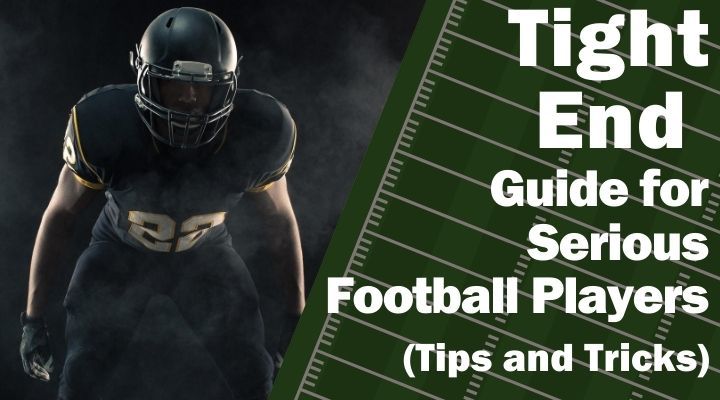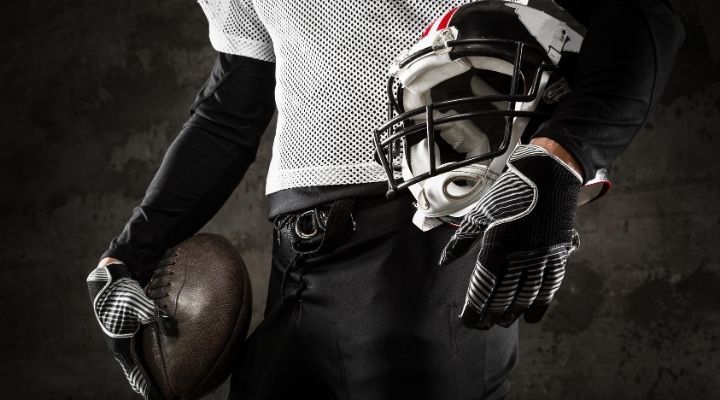Leave a Comment:
(2) comments
[…] Source […]
Reply[…] Especially at the collegiate and professional levels of the game, teams have opted to replace the traditional fullback for an extra wide receiver or tight end. […]
Reply
Tight end is one of the most physically challenging positions to play in football.
It’s a hybrid position that lies somewhere between an offensive lineman and a wide receiver.
Players at this position should not only be able to catch, but must also block strong and speedy defensive ends and linebackers.
When you think of players such as Tony Gonzalez, Antonio Gates, Rob Gronkowski, Shannon Sharpe, and Kellen Winslow, you often think about their success as receivers first.
But what makes this group of TEs among the best ever is when they aren't catching passers, they're huge contributors in the blocking game.
Below is an in-depth guide to the tight end position. What makes a great tight end, what they do, where they line up on the field, as well as a few tips to elevate your game.

Tight ends are hybrid players.
They have the size and strength of an offensive lineman, and the skill and catching ability of a wide receiver.
Offenses use tight ends as either passing options or as important blockers. Which is why TEs must be willing to take on big defensive linemen and linebackers.
While catching passes and scoring touchdowns may be what give them notoriety and big contracts, it's what they do on plays when they aren't catching that's crucial for the offense.
Elite tight ends have a very unique set of traits, talents, and skills that are hard to match.
They’re physical freaks, both in their sheer size and strength and their athletic ability.
Though they’re usually considered part of the offensive line, tight ends don’t have a fixed position when starting a play.
Depending on what the offense runs, tight ends usually find themselves either along the line of scrimmage or out wide.
On running plays, tight ends must be able to block well. This means helping on defensive ends and picking up outside defenders – which include linebackers, safeties, and sometimes even blitzing cornerbacks.
Offenses may even opt to for two tight ends, especially on obvious running plays where they need all the blockers they can get.
On obvious passing plays (like 3rd and long), tight ends may need to line up in the "slot" between the outside wide receiver and the offensive tackle.
Even when tight ends end up running routes, they usually have to disguise the fact that they will.
At the snap, they will help chip block to make the defense think they’re staying in. Only for them to release off the block and run their passing route.
As touched on earlier, tight ends are a mix of an offensive lineman and a receiver.
However, this doesn’t just apply to their physical size, strength, and athleticism.
As a hybrid position, tight ends will also have a hybrid set of roles and responsibilities.
When a tight end is called upon to run a passing route, it's extremely important that he draws attention from at least one defender, if not two.
The job of every player who’s asked to run a passing route is to get open, of course, but it's essential that a tight end work really hard to do so every time.
This is for two reasons:
(1) The simple act of working hard to get open will draw attention from multiple defenders since great tight ends are hard to cover. That’ll then free up space over the middle of the field for wide receivers and running backs to take advantage.
(2) Tight ends are often asked to be safety valves for the quarterback. If the wide receivers and running back aren't open, then the QB can always check down and throw to a tight end on the short part of the field.
Even on passing plays, the tight end has a responsibility in the blocking game.
It's important for the tight end to at least make minimal contact with the defensive end or linebacker who's lined up opposite him.
Even a slight push or jam with the hands will force the defender to take a different route to the quarterback when he's rushing.
By forcing him to change his angle, it'll buy the quarterback an extra second or two to throw the ball.
And as any quarterback knows, even one extra second is extremely valuable.
While catching passes is the glamorous part of being a tight end, he has an equal responsibility as a blocker.
But he can't just be acceptable in that category...
Every tight end must be able to serve as a reliable sixth offensive lineman.
If he's unable to do so, the team will be forced to call on its blocking tight end, which in turn will tip the defense off to what play the offense is calling.
Blocking takes a lot of strength and a lot of practice.
It may not come naturally to most tight ends, especially those who excel in the passing game. But it's something that they need to work on constantly, as it's one of the more important responsibilities they have.
Tight ends are going to get knocked around more than maybe any other position on offense.
That means that on passing plays, he often won’t' be able to take a straight path to where he's supposed to go.
Also, tight ends will often find crowded areas over the middle of the field during passing routes.
When this happens, they need to make quick adjustments to their routes to find a way to get open.
All of this takes improvisation skills, which ultimately means he must have great savvy and instincts for the game.
Tight ends are big, strong, physical specimen.
They’re not "big" like a traditional offensive lineman...
But they have size that gives them a distinct advantage over the safeties and linebackers who will be asked to cover them.
Gronkowski, Witten, and Jimmy Graham, three of today's top tight ends in the NFL, are all 6-'6", for example.
Having this height advantage over safeties -- who are normally closer to 6-feet tall -- and even linebackers will allow quarterbacks to throw balls higher and let the tight ends go and get it.
Besides height, tight ends need to be big-bodied and strong enough to take the pounding they will when they're blocking.
Tight ends are often asked to block some of the more athletic and strong defenders on the field -- defensive ends and outside linebackers.
They need size and strength to be able to do this.
Like just about every trait and skill of a tight end, this one will be used in two different ways.
In the passing game, tight ends will be called upon to be reliable targets for their quarterbacks.
They’re sometimes seen as safety valves when wide receivers aren't open.
Tight ends are often also targeted on shorter, more high-percentage passing plays to gain a few yards for a first down or score a touchdown when down close.
Tight ends also need to have great hands to be successful in the blocking game.
While tight ends are big, they often will give up some size to defensive ends.
When blocking a player who’s bigger than you -- and maybe even faster -- a key to keeping him in front of you is to use your hands.
Without a great pair of hands, tight ends would have a tough time doing well at their position.
One of the underrated things that tight ends have to do is create separation when running a passing route.
Sure, wide receivers have to do this, too, but they don't have to do it after lining up in a three-point stance.
They also don't have to create separation after getting bumped at the line of scrimmage by a big defensive end.
The simple act of getting open is very difficult for tight ends -- more so than any other position.
First, they have to burst out of their three-point stance. Then, they have to shed contact from a defensive end or linebacker. Finally, they have to create separation from a larger linebacker or safety.
The only way that a tight end can do all this consistently is by being athletic.
Tight ends need just the right combination of speed, strength, and elusiveness. They need to be quick with their feet and strong with their hands.
Once they do get open, they need to be ready to receive a strong throw from their quarterback.
This trait could also be labeled "body control."
To be successful, a tight end must always keep great balance.
When the play calls for him to run a passing route, he must be able to gain that separation from the line of scrimmage.
If he allows a defensive end to knock him off balance, he'll never be able to get open in time to receive a pass.
When the play calls for him to block, he must be able to keep his balance low, like that of any other offensive lineman.
This can be a difficult task, as tight ends aren't as big-bodied as these other offensive linemen.
Without great balance, it would be very hard for a tight end to do his job well.
The tight end is a key position in keeping a play call a secret from the defense.
A smart defender will try to key in on what the tight end is doing -- or, rather, how he reacts at the snap of the ball -- to determine whether the offense has called a run or pass play.
If the tight end is too quick to move downfield for his passing route, it will be a dead giveaway that the offense is attempting a pass.
If the tight end puts his head down and angles toward a defender, it'll be a dead giveaway that the offense is attempting a run.
And if the tight end pops up and looks around for defenders to pick up, it'll be a dead giveaway that the offense is attempting a pass -- and the tight end is staying in to block.
The tight end can't show his hand too early!
If he does, then misdirection plays such as play action passes or draws will never be successful.

There have been many great tight ends throughout the NFL’s history. Here are my picks for the top-10 tight ends of all time as of today:
1. Tony Gonzalez
2. Kellen Winslow
3. Rob Gronkowski
4. Shannon Sharpe
5. Antonio Gates
6. Jason Witten
7. Travis Kelce
8. Mike Ditka
9. John Mackey
10. Dave Casper
A tight end needs to be able to move laterally as well as he moves straight down a field.
He must be able to quickly shuffle his feet from side to side as well as straight ahead while blocking. And he must do all of this while exerting an immense amount of power.
When running a passing route, he must be able to shift from side to side, juke, and explode when he plants his feet.
To do all of this, a TE must have great footwork.
Standard shuffling and change-of-direction drills will help this a lot.
A tight end needs to have strong enough hands to block and soft enough hands to catch.
The way to do this is to first and foremost work on strengthening your hands, wrists, and arms.
This will help you absorb the contact with defenders when blocking and running passing routes.
After you do that, it'll be much easier to work on receiving the ball with soft hands.
A tight end has to have great instincts and great vision.
He must be able to identify open areas of the field based on what routes other players are running and what type of coverage the defense has called. Then, he must take advantage of those open areas and get to them.
When blocking, the tight end is the last offensive lineman on the line of scrimmage. A defender won't always be lined up directly across from him.
To still successfully block on plays like this, he has to be able to anticipate where the pressure is coming from and quickly identify his blocking assignment.
The best way to learn the game and gain instincts is to simply watch it -- as much as you can.
Focus in on a really good tight end and see how he reacts to every play. You can pick up a lot just by watching a master at his craft.

Tight end doesn't get a lot of notoriety on a football team, but great tight ends can be complete game-changers.
Just look at what Rob Gronkowski and Tony Gonzalez have done for their NFL teams in recent years.
They completely change how an offense operates and how a defense must respond.
Tight end is one of the more difficult positions to play because so much is asked of players who play the position.
If you want to get great at the position, work hard at learning the game and refining the skills you need early on.
[…] Source […]
Reply[…] Especially at the collegiate and professional levels of the game, teams have opted to replace the traditional fullback for an extra wide receiver or tight end. […]
Reply